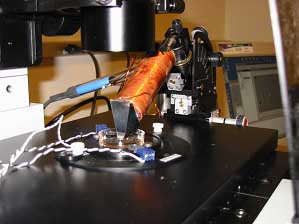So Lab - BEAM Bioinstrumentation Engineering Analysis and Microscopy
|
Research in the So Lab Magnetic Cellular Manipulation |
||
|
|
One way to explore the effects of mechanical stresses on cells and tissues is by applying focal forces via beads. Optical traps can apply a fixed strain to small polystyrene beads; however, the total force magnitude is small and requires feedback to regulate. Using electromagnets, alone or in an octopolar setup, it is possible to apply forces to magnetic beads in a controlled and time-dependent manner. |
|
 |
A single-pole magnetic trap is designed to exert high magnitudes - up to 20 nN on a single 4.5 mm paramagnetic bead. The octopolar (eight-pole trap) can only exert about 200 pN per bead, but it has the advantage that due to the configuration of the poles, an area containing hundreds of cells (with beads attached) can have the same forces, to within 10%, exerted on them. Figure 1: Picture of the single pole magnetic trap, set up on a microscope stage with a culture dish, a dish heater to keep cells at 37°C, and a gauss probe (blue) to provide feedback. |
|
|
|
Using the magnetic traps, we have started to characterize the physical deformations of the cells. Ongoing studies take advantage of the octopolar's uniform field to explore the molecular signaling on many cells at once, while keeping the single-cell information. Figure 2: Two-photon image of an NIH 3T3 fibroblast expressing GFP-actin, with beads attached (left) and with beads attached and a force exerted downward by the octopolar magnetic trap (right). |
|
[ So Lab - Mission Statement - Research - People - Documents - Facilities - Links - Resources - Sign-up Sheets ]
Comments about this webpage? Email us!